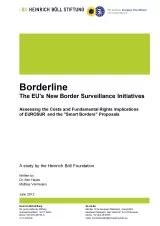Borderline - The EU's New Border Surveillance Initiatives
The research paper “Borderline” examines two new EU border surveillance initiatives: the creation of a European External Border Surveillance System (EUROSUR) and the creation of the so-called “smart borders package”, which includes the establishment of an Entry-Exit System (EES); and the creation of a Registered Traveller Programme (RTP). EUROSUR promises increased surveillance of the EU’s sea and land borders using a vast array of new technologies, including drones (unmanned aerial vehicles), off-shore sensors, and satellite tracking systems. The EES would record the movement of people into and out of the Schengen area and extend biometric ID checks to all non-EU nationals (including those not currently subject to EU visa requirements) with the aim of helping border guards identify “overstayers”, i.e. individuals that have overstayed their legal permission to stay.
Taken together, both programmes could cost in the order of €2 billion or more. They would result in the gathering of biometric data on millions of travellers, longer waiting lines at the EU’s external borders, and the establishment of costly new border surveillance systems in the member states and at FRONTEX, the EU border agency.
The European Commission has produced several impact assessments but, according to the report, these have failed to demonstrate a pressing social need for the new systems. The Commission’s financial estimates have a wide margin of error. EU institutions have failed to take into account the insurmountable difficulties that the United States has faced in introducing comparable systems (US VISIT, which is still unable to record the exit of travellers from the United States; and SBINET, a border surveillance system along the Mexican border that was scrapped after technological problems and exploding costs). The authors call for a proper public debate about both the need for yet more expensive EU-wide databases and surveillance systems in an era of crippling austerity.
The report is also critical of the decision-making process. Whereas the decision to establish comparable EU systems such as EUROPOL and FRONTEX were at least discussed in the European and national parliaments, and by civil society, in the case of EUROSUR – and to a lesser extent the smart borders initiative – this method has been substituted for a technocratic process that has allowed for the development of the system and substantial public expenditure to occur well in advance of the legislation now on the table. Following five years of technical development, the European Commission expects to adopt the legal framework and have the EUROSUR system up and running (albeit in beta form) in the same year (2013), presenting the European Parliament with an effective fait accomplit.
